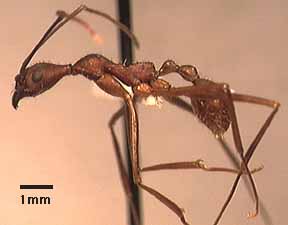
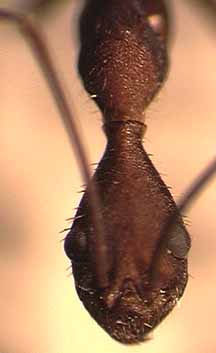
| return to guide introduction | go to genus list |
|
 |
One species or species complex in Costa Rica (A. araneoides); monomorphic; large (as in figure) with long scapes; antennae 12-segmented with no club. Nest in soil; moderately common in wet forest.
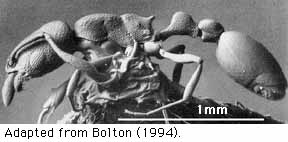
Uniform habitus; 12-segmented antennae with 3-segmented club; no erect setae; surface of body dull, micropunctate, not shiny; postpetiole swollen in dorsal view. Tramp species common in highly disturbed areas; nest in ground, arboreal.
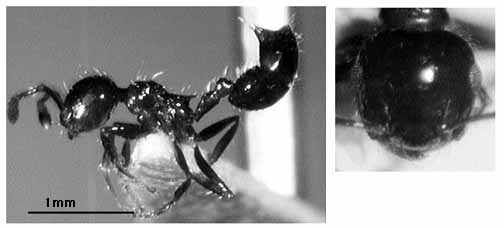
Uniform habitus; little size variation; postpetiole attached to dorsum of gaster; gaster heart-shaped and often held vertically in life; petiole lacking dorsal node; propodeal spines always present, no other spines. Arboreal; often dominant ants with large colonies; common.
NESOMYRMEX and TEMNOTHORAX (formerly Leptothorax)

Diverse habitus; antennae 11 or 12-segmented, without distinct club; mesosoma lacking dorsal sutures; always with propodeal spines. Arboreal; common but colonies usually small, cryptic, workers sparse.
|
 |
Moderately uniform habitus; monomorphic; antennae 12-segmented with 3-segmented antennal club or segments gradually increasing in size distally; no spines or tubercles of any kind; body completely shiny. Large arboreally-foraging species to tiny, cryptic species in forest leaf litter; nest in soil or leaf litter; a few species specialized inhabitants of attine nests; uncommon.
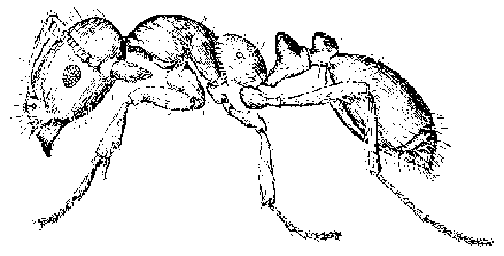
Uniform habitus; monomorphic; antennae 12-segmented with 3-segmented antennal club; no spines or tubercles of any kind; only 3 species in Costa Rica, all introduced tramp species; two are shiny, common low arboreal species in highly disturbed habitats (all black: M. ebeninum; black with brown mesosoma: M. floricola); one (M. pharaonis) is yellow, uniformly punctate, and found only as a common house pest. Monomorium is difficult to distinguish from Megalomyrmex, but the latter is usually in mature forest. In the field, Monomorium are very similar to small Solenopsis.
|
Very diverse habitus; polymorphic with discrete major caste; one of the larger species figured here, but size range includes small species with workers approximately 1mm long; antennae always with 3-segmented club; antennae usually 12-segmented, rarely 11 or 10-segmented; propodeum usually with pair of teeth, but these may be reduced to denticles, ridges, or absent; promesonotum lacking spines or dorsally-directed tubercles (at most laterally-directed humeral projections); propodeal suture always present, promesonotal suture present or absent; antennal scrobes generally absent, present in majors of a few species, faintly impressed or absent on minors of these species; mandibles always triangular; mandibular dentition irregular, often with diastemma between teeth; sculpture and pilosity highly variable. Extremely diverse habits; extremely common, one of the most frequently encountered genera.
SOLENOPSIS

Uniform habitus; antennae 10-segmented with distinct 2-segmented club; mesosoma lacking spines or tubercles; largely smooth and shining with variably developed patches of punctate sculpture. Tropical fire ant, S. geminata, is large, polymorphic, with large multifaceted eyes. Many species of small Solenopsis ("Diplorhoptrum") have eyes reduced to few facets or absent, and most are monomorphic (at least one species of small Solenopsis has a distinct major caste). S. geminata nests in soil, and makes conspicuous excavated soil mounds over the nest. It is a common species in open areas and agricultural landscapes. The small Solenopsis are diverse in species and habits. Many are cryptic ants in leaf litter and soil, others are conspicuous arboreal ants. They are generally abundant in most habitats.
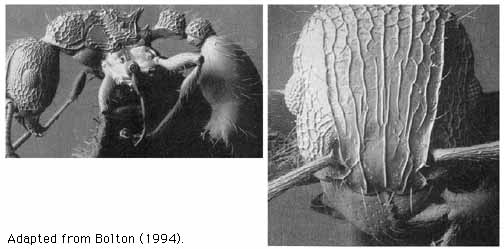
Antennae 12-segmented; shallow scrobes; lateral portions of clypeus raised into sharp ridge or wall in front of antennal insertions. Two tramp species in Costa Rica; T. simillimum small, very similar to Wasmannia auropunctata in habitus; T. bicarinatum larger, bicolored, with red brown head and mesosoma, black gaster. Both usually found in or near dwellings.

Variable habitus; antennae 11-segmented, usually with 2-segmented club; lateral portions of clypeus raised into sharp ridge or wall in front of antennal insertions. Variable nesting habits, terrestrial or arboreal. One widespread tramp species (W. auropunctata) very common; other species rare in mature forest.
Page author:
John T. Longino, The Evergreen State College, Olympia WA 98505 USA. longinoj@evergreen.edu